Week 11: Break Testing and Presentation Prepping
May 14, 2024
Week 11:Compresssive Strength Tests and Presentation Goals
Hello once again everybody, we are in the final report before the presentation on Saturday. I hope everyone’s excited to see (and share) their work! On my end this week, I’ve:
- Prepared and performed the compressive strength test on the non-acid treated Coconut Shell Ash cubes at Cemex with the help of Nick.
- Got the 4-week test results on the industrial Coconut Shell Ash concrete.
- Started curating my data and research for the final presentation (and research paper).
So let’s get into it!
Cube Testing (Non-Acid Treated)
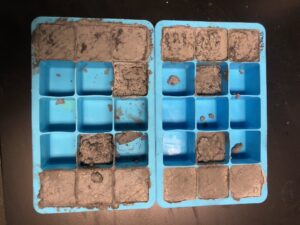
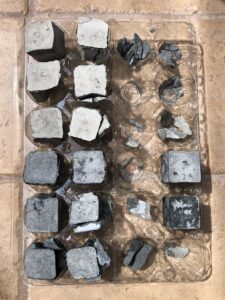
After rehydrating the first set of cubes (Control 0% CSA, 10%, and 20% non-acid CSA) on Monday (to help them gain strength), I brought them to Cemex. There, Nick helped me measure them up then crush them. This was very sad for me as I had come to like them over 15 days. Anyway, due to the small cube size, there was no loud cracking noises, but it was still entertaining seeing the variations in strength and cracking patterns. This inconsistency also shows the lack of control in hand-mixing ass compared to industrial mixes, which usually show a <8% variation between samples in a batch. Still, I will analyze the data and prepare for Friday 5/17’s (cutting it close) acid cube compressive tests.
Chemical Analysis of Acid Treatment Residues

After the re-separation of the coconut shell ash from the 4 acid solutions last week, I discussed the interesting formations of solid at the bottom of the beakers. For this reason, I’m asking Cemex if they can perform a chemical analysis of the residual solutions and see if any part of the coconut shell ash was separated out. If what separated out was an impurity/salt like Sulfur, which could reduce concrete strength, then that would be great. But if it somehow separated out a pozzolanic material such as alumina, silica, etc., that’s less ideal. This is why we do science: for the unexpected and exciting outcomes.
Industrial Test Results from Cemex – 28 Days
Let’s get to the results (pictured below). Somehow, the burned CSA has a similar strength to the previous unburned CSA, despite being at a lower % replacement than before. As we can see in the 4th graph below, the burned is indeed weaker than the old unburned version. This is perplexing, as burning means lower content, which should mean a higher concentration of strength-giving chemicals like alumina, silica and calcium oxide. We have to wait for chemical analysis and see why this disappointing result occurred.
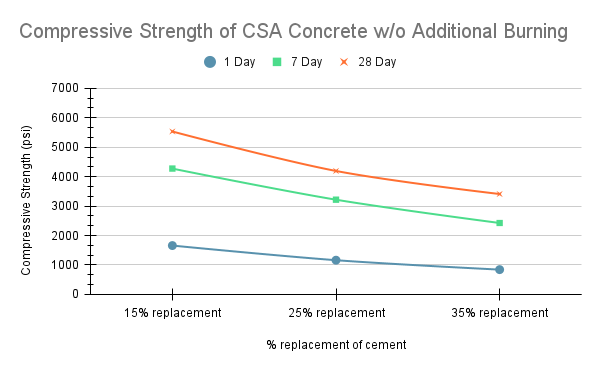
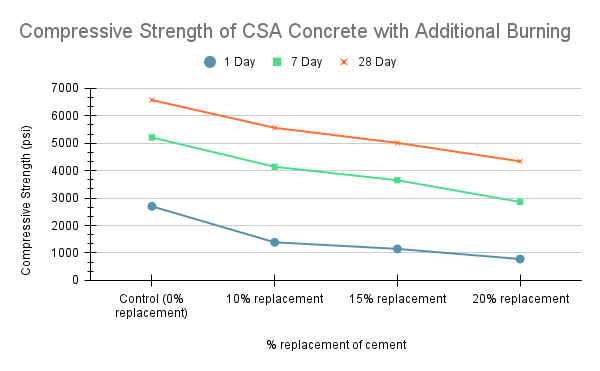

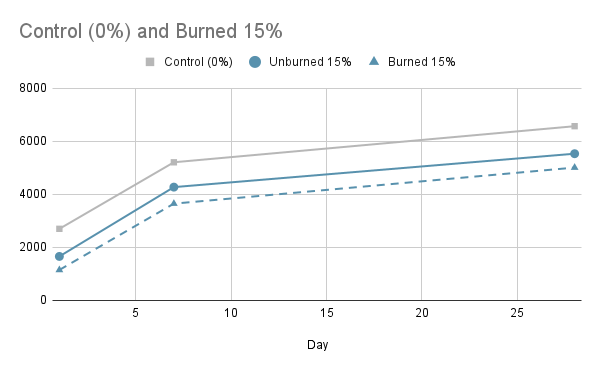
Still, I believe bad results are just as valuable as good ones, although sometimes the science publishing community doesn’t think so. The failure here is more interesting than a success would’ve been, and gives me more burning questions to answer in the future as I gain more data. Fascinating.
Presentation Preparations
Concrete can seem boring. We see it every day and it doesn’t do anything like nanotechnology does or AI does or quantum mechanics does, but it is very important. I want to use pictures and easy-to-understand language to make concrete exciting and communicate the massive role it plays in climate change. The current plan is to seamlessly transition through background information, then the literature review, followed by industrial test and acid treatment (pending) results, and finally a strong conclusion. I fear I will go over time, but I will make that sacrifice for concrete. Another goal is to inspire people to think interdiscipline-arily when thinking of global issues such as climate change, as only a culmination of perspectives leads to feasible and equitable changes in society.
Thanks for reading the penultimate post, and I hope to see you all soon (don’t be late like Sidhant).
Max Polosky

Leave a Reply
You must be logged in to post a comment.